► Lucid Air vs its EV limo rivals
► Poshest electric limos compared
► Which comes out on top?
A stunning US rival gives green-minded executives an intriguing new alternative to Tesla, Mercedes and BMW. Here, we test the Lucid Air against the Tesla Model S Plaid, BMW i7 and Mercedes EQS.
Lucid Air: the briefing
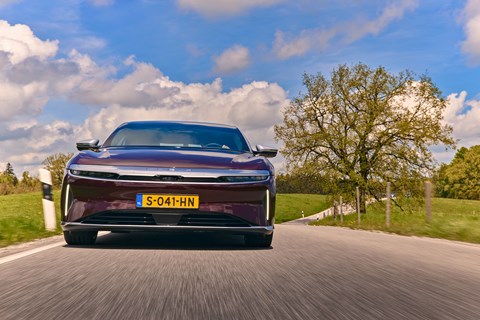
Where does the owner shop?
Online! Using contactless! And bitcoin! While wearing Apple Vision Pro Goggles!
Is this a car for the passengers as well as the driver?
Lucid has the best luggage capacity front and rear, but the rear seat is uncomfortable.
Have they given the driving modes peculiar names?
Hmm, ish: Smooth, Swift and Sprint.
Can it cope with ultra-rapid charging?
350kW max; just 20 minutes could get you from 10 to 80 per cent full; WLTP upper range figure is 524 miles.
Tesla Model S Plaid: the briefing
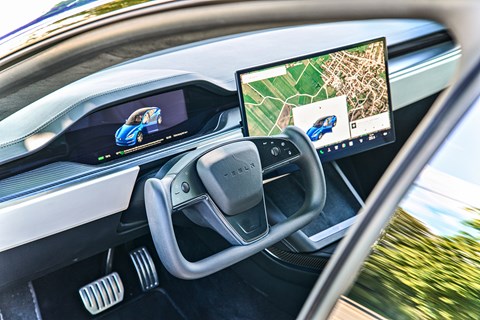
Where does the owner shop?
Hamleys, the self-styled finest toy shop in the world. Good for gaming, racing drones, Barbie dolls and whoopee cushions.
Is this a car for the passengers as well as the driver?
Roomy and comfortable enough, but the ambience is low on luxury.
Have they given the driving modes peculiar names?
Hell yes: Launch, Cheetah, Drift, Plaid, Sport, Chill. (Plaid? It’s a reference to the movie Spaceballs.)
Can it cope with ultra-rapid charging?
250kW max; 10 to 80 per cent full in 29 minutes; WLTP upper range figure is 373 miles.
BMW i7: the briefing
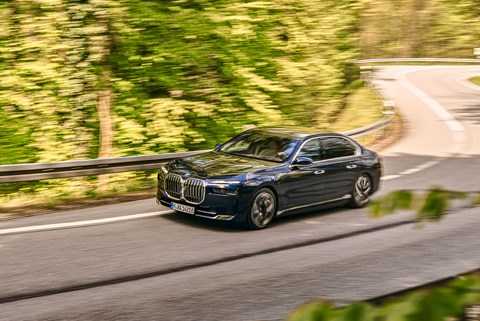
Where does the owner shop?
American Golf. Because that’s where you buy golf clubs.
Is this a car for the passengers as well as the driver?
Roomy and comfortable, with a traditional roofline that leaves head space uncompromised.
Have they given the driving modes peculiar names?
Getting there: Personal, Sport, Efficient, Expressive, Relax, Theatre, Digital Art.
Can it cope with ultra-rapid charging?
195kW max; 34 minutes from 10 to 80 per cent full; WLTP upper range figure is 374 miles.
Mercedes EQS: the briefing
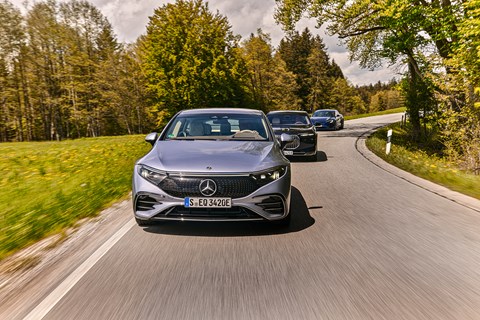
Where does the owner shop?
Currys. Huge choice of things with massive screens.
Is this a car for the passengers as well as the driver?
Rear door shape makes getting in tricky; seat’s lack of comfort makes you wish you hadn’t bothered.
Have they given the driving modes peculiar names?
No, just the standard non-AMG selection from Merc: Eco, Comfort, Sport and Individual.
Can it cope with ultra-rapid charging?
200kW maximum charge rate; 10 to 80 per cent in 31 minutes; best-case WLTP range figure is 420 miles.
Lucid Air vs Tesla Model S Plaid vs BMW i7 vs Mercedes EQS: the test
If all the classes of car, the executive saloon is better suited to going electric than anything. They’re big enough to cope with the extra weight, and unlike more sporting cars they can sell their near-silence as a virtue. And, price-wise, they were already heading for five-figure territory, even before EV development costs came into the picture.
But let’s face it, not a single one of those sensible points is in the thoughts of the crowds that gather around the Lucid everywhere we go. It’s an absolute people magnet. Even among such an imposing, eye-catching bunch, it’s the new American saloon that people want to look at. That’s partly down to the novelty of a new badge – one that’s only just arrived in Europe, and not yet made it to the UK market – but that magnetism must also be in large part attributable to the sheer presence of the Air Grand Touring.
Lucid has been edging ever closer for several years now, with the first Air saloons leaving the Arizona factory just under two years ago. It’s aiming to build more than 10,000 cars this year, with an SUV, the Gravity, due in 2024. It’s clearly aiming in some ways to be the new Tesla, minus much of the Musk nonsense, but of course the old Tesla is still going strong… very strong.
The focus lately has been on the Model 3 and Model Y, both huge sellers in Europe, but Tesla has also found time to significantly overhaul the venerable Model S, now also available as the ultra-powerful, ultra-rapid Plaid. It’s much more powerful than the Air, while still being essentially what it always was: a big, comfortable, fast saloon.
And when you’re talking premium executive transport, you inevitably need some German cars in the conversation. The Mercedes EQS is – like the Air and Model S – a pure-electric creation. Our BMW, an i7, is the only car here that’s also offered with an engine; hybrid 7-series are now available alongside the all-electric i7.
Put them together and you find an intriguing choice of classy transport for the executive who enjoys driving but doesn’t want to be seen as part of the climate-change problem. Those high flyers are probably more open than ever to switching away from their default German choices. Some who have sampled BMW and Mercedes EVs may have found themselves disappointed or frustrated by cars that are ambitiously complex in concept and yet compromised in execution. A BMW that doesn’t look or drive like BMWs used to? A Mercedes that stubbornly ignores core brand values? If there are viable alternatives, why stick with old habits?
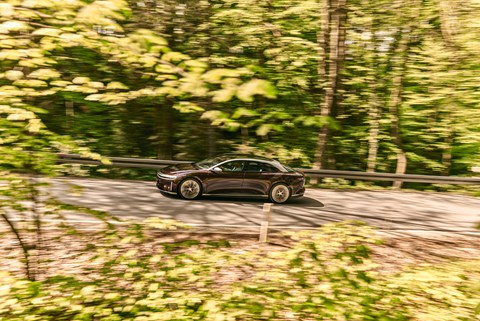
Let’s go straight to the Lucid. Like the intrigued onlookers, we’re very keen to find out just what it’s like and how it copes with European conditions up against some familiar benchmarks.
With a claimed drag coefficient of 0.197, the Air Grand Touring narrowly eclipses the EQS (0.20), the Tesla (0.21) and the BMW (0.24). Other USPs of the newcomer from Silicon Valley are the large 283-litre frunk, supplementing the sizeable 627-litre boot, a maximum charging power of 350kW, which promises shorter battery-juicing stops than the competition, and a very useful-sounding WLTP range of up to 524 miles.
Forget about the 0-62mph sprint, which is a once-in-a-lifetime 3.0sec affair. What really matters more than its ability from a standing start is the acceleration on the fly, which is quite awesome.
While the Merc quits the leadfoot contest at a humble 130mph and the BMW at 149mph, the silver-over-maroon beauty pulls 168mph. To hell with range anxiety! Surely it’s ready for a duel with the Plaid…
Although the Lucid loses the 0-62mph sprint by 3.0 against the Plaid’s 2.1 seconds, it’s still incredibly quick by super-saloon standards, EV or not. Less brutal than the Tesla, the Air behaves in a more composed manner, is equally well balanced and simply loves corners, not merely the show-off straights where the Model S excels. The steering of the Air Grand Touring expertly fuses intuition and feedback, its brakes are potent and responsive, the chassis talks you through its motions in a confidence-inspiring fashion, and there is an unfiltered honesty in every move this precision tool makes.
Downsides? Even the lower of the two regen stages is quite aggressive and thus too close to the controversial one-pedal feel, which requires constant throttle adjustments to maintain a steady flow. The drive modes are not sufficiently pronounced to have an immediate effect on the dynamics, but that’s not a problem because with up to 885lb ft of torque the right hoof calls the shots and not the ECU.
At an WLTP-endorsed 4.2 miles per kWh, the Lucid is the most efficient car here. It also has the most potent battery, rated at 112kWh, and it weighs less than the Germans (but more than the Tesla). At 2715kg, the BMW packs 450kg more body fat than the Tesla, and you can feel it. The Air shares its footprint with the Plaid while being 240mm shorter than the Benz and undercutting the sprawling i7 by 416mm. As a result, both US products feel nimbler and more chuckable than the German establishment.
It’s worth remembering that Lucid main man Peter Rawlinson was formerly with Lotus, Jaguar and Tesla. He knows what’s he’s doing with car dynamics, and that shows in the Air. But there is a price to pay for the more inspiring handling, the sharper responses and the more aggressive set-up, and that’s the stiffer suspension provoking a harsher ride. Tesla and Lucid are both firmer and less compliant overall than the German cars, and in both cases it’s the rear in particular that raises complaints regarding minor jolting and a restlessness on bumpy roads – proper magic carpets are smoother and more supple.

The Model S, a 15-year-old design which became Tesla’s breakthrough model a decade ago, is still highly convincing. How does it fare against the newbies? The sheet metal shaped by Franz von Holzhausen has aged remarkably well, and the once futuristic interior with its large iPad-style centre monitor is actually more user-friendly now than the busy Mercedes Hyperscreen and the over-sexed i7 cockpit.
While the Autopilot system remains a bone of contention there’s no denying Tesla’s software leadership and its multi-faceted advantages in the powertrain department. The constantly growing Supercharger network remains a big, fat asset. Hassle-free purchasing, competitive lease rates and strong resale values are further plus points, but the perceived quality could be better. And let’s not even mention the potentially off-putting Elon Musk effect.
The Plaid is better equipped and better made than previously tried Teslas, but the perceived quality is still not fully premium, and the now optional yoke is no match for a proper steering wheel because displacing your hands while winding on lock can mean losing grip altogether.
The fingertip controls, on the other hand, become second nature within an hour or two, and even the vertical touchslider which selects the direction of travel is not such a bad idea after all.
The landscape position of the XXL touchscreen also helps, as does a much-improved menu that is now mostly self-explanatory, and the voice control works really well – an asset the Model S shares with these rivals. Again, as with the Lucid, energy regeneration is of the pushy-intrusive kind here, but then who cares when you’re at the helm of a humble saloon which just out-accelerated a Bugatti Chiron from zero to 100mph? Not to mention that 4.65sec vroom-beam from 60 to 130mph.
Any Model S is a cool tool, and to drive the Plaid is particularly sensational. Accelerating to 62mph in a claimed 2.1sec is the sort of thing few civilians ever experience. And indeed on our test car’s 19-inch wheels and winter tyres, nor do we, but even so it’s gloriously quick, like the proverbial bat out of hell. Flooring the throttle from a standing start feels as if some physical superpower is tearing the tarmac backwards with a vengeance while at the same time sucking in the horizon.
Choose your preferred attack mode and the Tesla’s black box will mastermind the appropriate battery conditioning, regenerative braking, torque vectoring, side-to-side rear torque split, stability control, damping and ride-height adjustment. Each program is accompanied by its own graphics and soundtrack, so brace yourself for a Marvel-goes-F1 experience. But beware – the brute force that’s always only a stab on the throttle away can come as a shock.
And so will the increase in energy consumption. According to the WLTP results the two Germans and the two Americans are similarly frugal, but once you give them stick the energy depletion soars way off the chart. Driven flat-out on the autobahn from Munich to Stuttgart in the early hours of a weekday, the advertised range shrinks in no time from 390 to under 200 miles (i7) or from 524 to a tad over 300 miles (Lucid). Make no mistake: high-performance EVs still cannot match their combustion rivals as long-distance high-speed chariots. They simply use too much energy when pushed hard, and they take too long to replenish it. The Lucid Air Grand Touring can charge with up to 350kW, followed by the Tesla (250kW), the Mercedes (200kW) and the BMW (195kW).
While the i7 spends at least 34 minutes hooked up to the mains for a charge from 10 to 80 per cent, the EQS exits the waiting area crawling with nail-biting smartphone junkies after 31 minutes while the Tesla is back on the road after 29. The Lucid does the job in 20 minutes flat, a remarkable achievement worth a big bonus diamond because every extra minute of waiting time hurts. A selling point? It certainly will be, except at the moment Europe is not exactly overpopulated with 350kW fast chargers.
Performance-wise, the Teutonic titans struggle to compete with their New World rivals. The stopwatch records a ho-hum 4.7sec 0-62mph time for the i7, but as soon as the hammer drops the predictive sat-nav starts altering the state of charge and recommended charge points at 30-second intervals, which is not our idea of relaxed presto highway cruising.
If Rolls-Royce built a Ghost EV, it would probably drive very much like this battery-powered BMW. The i7 feels sweeping and portly despite the rear-wheel steering, which must do with a token angle of 2.5º, while the complex anti-roll assembly is occasionally at odds with the softish air springs, and the 21-inch Pirelli P Zero tyres stick like honey to a cashmere sweater yet mar the low-speed ride. Delivering 536bhp and 550lb ft all told, the two motors spread power and torque evenly, which befits the luxury character of the car but stifles the happy handling harmony associated with the best 7-series.
Step out of the BMW and into the Mercedes, and you will be surprised to find the EQS more of an ultimate driving machine than the i7. Less powerful but lighter, the Benz beats its arch-rival by 0.4sec to 62mph. Believe it or not, the EQS is the sportier and more involving car. It rolls less and won’t heave as much over long, winding undulations tackled at speed, it steers with more enthusiasm and matching accuracy, and – hurrah! – its brakes have at last shed most of that awful sponginess, the excessive pedal travel and the disproportionate effort which haunted all EVA2-based EVs until this recent fix.
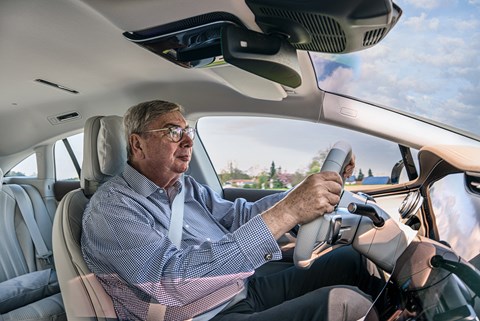
Another bonus point is the optional all-wheel steer (standard fitment on most UK models), which permits up to 10º of rear steering angle for an unrivalled turning circle of 10.9 metres. However, while the EQS benefits from its CLS-type dynamics, it’s handicapped by its CLS-type packaging.
The BMW may not be much of a looker, but it has one big advantage over the others, and one that’s particularly important for this type of car: roomy and comfortable rear seats. Put the cars side by side and part of the explanation becomes obvious: the BMW’s traditional saloon shape leaves room for full-size passengers, whereas the EQS in particular is quite coupe-like.
If you think the EQS is a fully electrified S-Class equivalent, think again, because it’s not. Where the top-of-the-line Mercedes-Benz combustion-engined saloon is a stately carriage featuring a generously sized upmarket cabin which mixes manageable digitisation with top-notch craftsmanship and neat detailing, the EQS is in contrast a modern and pleasantly airy premium speedboat tiled with extra-large displays and touchscreens, furnished with fancy multi-mode seats and wrapped in truly splendid acoustic isolation.
The materials used below the primary field of vision are, however, not up to scratch, while the colour and ambient lighting schemes border on being tacky. And what good is a boot which can swallow between 670 and 1770 litres of Dom Pérignon if the trade-off is entry and exit to the rear passenger compartment compromised by the prematurely dropping roofline and the intruding tailgate hinges? There are redesigned rear seats coming for model year 2024, but right now the back benchers are struggling with scant headroom and uncomfortably low H-points.
The rear compartment of the Model S is sufficiently roomy, but to qualify as American electric S-Class it would need more features and style, and even though they almost doubled the hide-trimmed acreage over the Model 3 the ambience still only matches the business-class seating of a budget airline.
The Lucid scores even fewer packaging points because of its uncomfortable rear bench. It is too short in the cushion, insufficiently padded, and it seats the passengers at an odd upright angle with the legs sharply bent and the knees up in the air – tall occupants are actually better off in the back of a Skoda Superb.
There are many other examples of these cars falling oddly short. The BMW may be hugely comfortable but it’s lacking in those coveted dynamic BMW genes. The EQS fuses a sub-par cabin trim with chic catwalk looks and oddball packaging. The Air has a functional rather than fancy driver environment, although it’s positively lavish next to the simple Tesla.
Why is there no unanimous winner, not even a firm ranking? Because even though common sense says that these four contenders are very much aiming at the same buyers, when it comes down to the detail they are too dissimilar for direct comparisons to have their usual weight.
Lucid Air vs rivals: the verdict

In a neater universe, our foursome would have been slightly different. Perhaps the more powerful Mercedes-AMG EQS 53 and BMW i7 M70 would have been involved, but in practice neither was available for this test. And although we were understandably keen to test this newest Tesla Model S, the Plaid, in reality a less expensive, less powerful version would have been a closer fit for most of the rivals. As far as the Lucid is concerned, the 612bhp Air Touring would have been the more appropriate choice, except that the Touring and the entry-level Pure were still in transit from the Arizona factory to Holland while the test was already in full swing.
So rather than a ranking from fourth to first, let’s sum up the strengths and weaknesses of each. The Tesla Model S Plaid is an insane piece of kit, period. With so much power, you need a very straight stretch of very even and dry road, or one of the safety chips will push the ‘game over’ button. This cannonball drive is huge fun but permanently on the brink, so much faster than anything else on the road, and eerily quiet on top of it. In terms of sheer go and brutal velocity, stealth appeal and value for money, nothing else comes close.
The BMW i7 is a cosseting carriage, and when fitted with the right selection of extras can become a mobile cinema or an office. But whatever box you tick, it’s not going to turn the Bavarian waftmobile into a hardcore driver’s car.
Unexpectedly, the EQS does a better job than the i7 at clipping apexes, cresting brows at speed and trying to stay hot on the heels of the two US cars. It’s a reasonably sporty five-door coupe, not an electric S-Class. But you might do well to save yourself around £30,000 and go for the marginally smaller, and even more enjoyable, AMG EQE 53.
And what of the star attraction? The Air Grand Touring may not be the highest-tech thoroughbred, nor the fastest EV, but it is a smart buy, a charming alternative to the big-status badges, and almost as mind-boggling as the Model S Plaid when unleashed in the middle of nowhere after midnight. Furthermore, its charge time vs driving range equation is positively compelling.
Be patient, wait for the Lucid that’s right for you to come along, and you may well find it has the beating of any opposition.